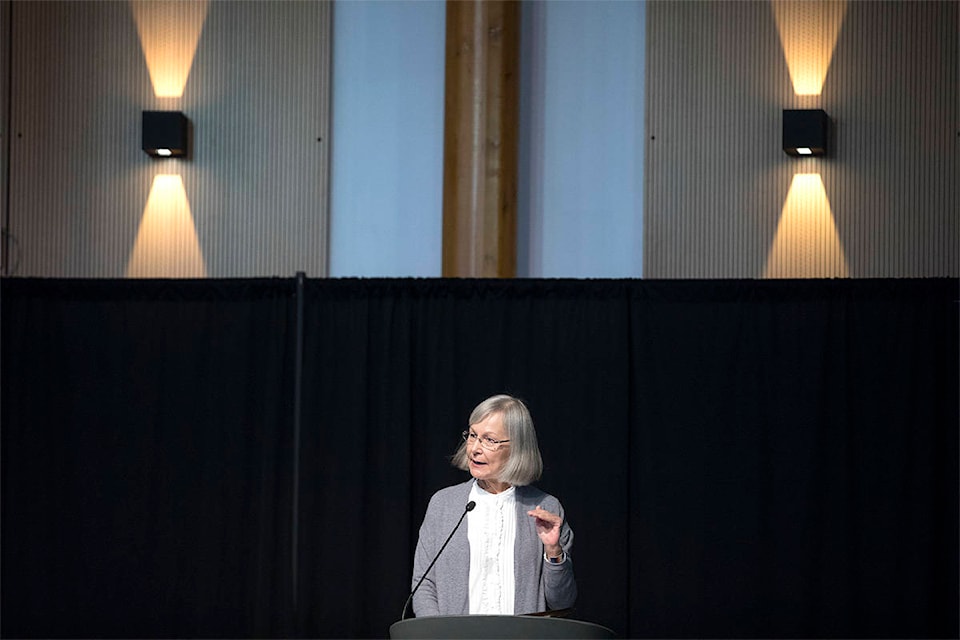The Canadian justice system would benefit from learning about and adopting Indigenous justice practices, which focus not on punishment but healing.
That was one of the main messages that Marion Buller Bennett, a judge and the chief commissioner of the National Inquiry into Missing and Murdered Indigenous Women and Girls, delivered during a keynote speech in Whitehorse on Feb. 27.
Buller Bennett was one of several speakers at the Council of Yukon First Nation’s two-day conference, “Exploring Justice: Our Way,” held at the Kwanlin Dün Cultural Centre.
In a nearly hour-long address, Buller Bennet touched upon not only the work and findings of the national inquiry, but her views of, and experience in, both Canadian and Indigenous justice systems, and why the latter works better.
“What separates Indigenous justice from non-Indigenous justice is healing … The process brings about healing for everyone. It also means restoring or building healthy relationships,” she said. “This takes time. It takes as long as it takes.”
In the Canadian system, some of the rules aren’t obvious to people who don’t work in the system and there are many that “do not make any sense whatsoever,” she said. There’s also little, if anything, that people affected by the problem before the court can do to help craft a solution, and there’s “little education about what’s right and what’s wrong, just punishment.”
“There’s no time,” she said. “Everything’s rush.”
“We as Indigenous people find justice our own ways and our own ways work, because there is education, there is healing, and there is balance,” she continued. “… The Canadian justice system can benefit from our ways of justice.”
Buller Bennett criticized the current incarceration rates of Indigenous people in Canada, despite efforts over the years to lower their over-representation in jails and prisons. The Canadian state, she said, has also “criminalized poverty,” punishing people who steal food or turn to the sex industry, for example, not because they’re hardened criminals but because they’re poor.
“Too many of our Indigenous women and girls, Indigenous men and boys, are growing up in prisons and penitentiaries across Canada,” she said.
“They are being held in institutions that are based on control and punishment. Now, does this sound familiar to anybody in this room? Is history repeating itself? Are these the new residential schools?”
“I’m not saying we have to go soft or easy on crime,” she said later on. “Sometimes there has to be jail. Sometimes that’s the only realistic option. But we need to get to the root causes of the offending.”
Buller Bennett said she believes the root cause of many problems — substance abuse, violence, criminal activity — is trauma that hasn’t been acknowledged and properly addressed.
Work is underway, though, to fix that, she noted, and gave an example of “real change, real people” in British Columbia’s Indigenous courts, also known as First Nations courts.
Created about 14 years ago, Indigenous courts fall within British Columbia’s provincial system and are currently present in seven communities — New Westminster, North Vancouver, Duncan, Prince George, Williams Lake, Kamloops and Merritt.
“The goal is to hold Indigenous people accountable and responsible for their actions,”
Buller Bennett said. “The next goal is to help people heal from trauma and get to the root cause of the offending, which is trauma.”
Each court, she explained, is “subtly different” because they all reflect the practices that are appropriate for the territory. They’re run by judges with training in Indigenous history and trauma, and are “usually pretty full,” with probation officers, counsellors and people working at local shelters often attending.
One thing they all have in common is that elders attend and “have a large, vital role in the process,” Buller Bennett said.
The courts are open to Indigenous offenders who have pleaded guilty to their charges; following their pleas, judges order “a variety of reports.” Everyone then comes together at the next appearance to create a healing plan for the offender, referred to as a a client, who has “direct input” in the process.
“The first question to the client is, ‘So what do you think you need to heal?’’ Buller Bennett said, noting that generally, the person knows exactly what they need. If they don’t, the elders, who typically know the offender or their families, will tell them “in no uncertain terms.” Victims have input as well.
Healing plans may include attending sweats, going to treatment and making reparations to the victim or victim’s family; the offender must also regularly check in with the court to ensure the plan is being followed and working.
“Now, if somebody isn’t doing the work that they need to do on their healing plan, the elders are the first to tell the client to smarten up and get on with their work — what do you need, how can we help you?” Buller Bennett said.
It’s the elders, not the judge, who decide if a client has successfully completed a plan.
“It’s gotten to the point now where non-Indingeous offenders want to participate in Indigenous courts — see? The door’s opening, it’s cracking open a little, and they’re starting to see that our way works,” Buller Bennett said.
“I’ve described some of the courts not to tell you what to do, not to say what we do in British Columbia is right and you should follow it, but I’m telling you about this and the work we did at the national inquiry to encourage you to find your own solutions to problems that you see in your communities.”
“… In closing, I want to say, change can be frightening. Sometimes it scares people. But we know that our ancestors embraced change. Change came with every season and they embraced that change. So must we.”
Contact Jackie Hong at jackie.hong@yukon-news.com
